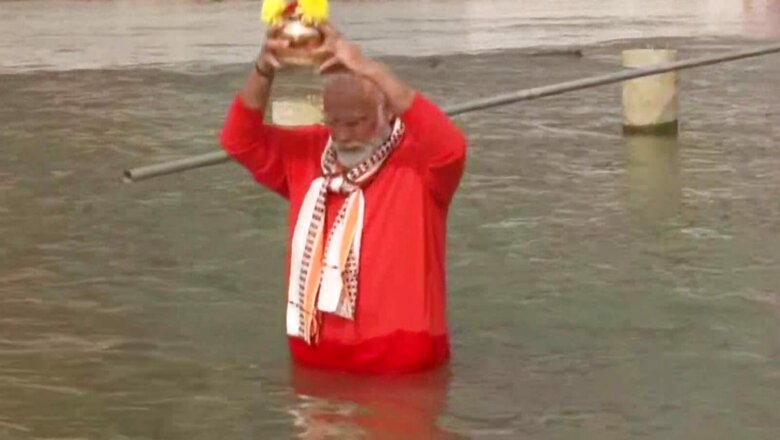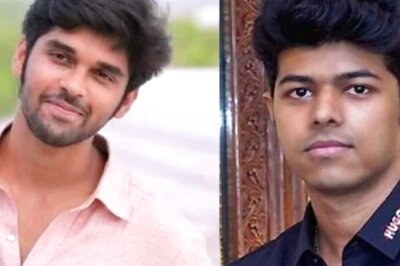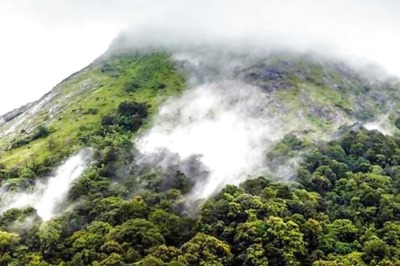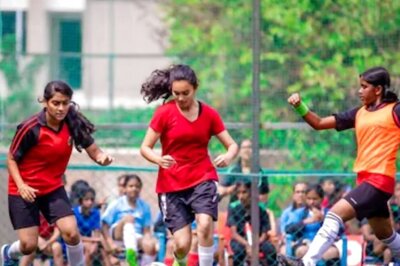
views
Prime Minister Narendra Modi’s ambitious Project Arth Ganga has been initiated to showcase local products and crafts, using organic farming in the basin area and generating employment helping the place become self-reliant.
Promoting Yoga, adventure and Vedic education and eco-tourism on the Ganga Ghats are a few ideas, which are set to take shape soon. Several institutions have been roped in for the project.
G Asok Kumar, director general for the National Mission for Clean Ganga (NMCG), speaks to News18 on picking up pace of the Project Arth Ganga, cleanliness of the river and expanded scope of work that now includes other rivers as well.

Q: What is Arth Ganga and what steps are being taken to promote it?
A: This is the concept given by the Prime Minister during the National Ganga Council meeting in 2019, which primarily means using economics as a bridge to connect people with rivers. The PM also talked about the GDP contribution from the Ganga basin. This meeting took place in December 2019 after which the Covid-19 pandemic started. We have now begun working on Arth Ganga.
Q: Have you identified the fields where Arth Ganga will be implemented?
A: We have identified six verticals on the lines of the PM’s thought to be taken up in an integrated way.
Zero-budget farming: The first is zero budget natural farming or zero chemical farming on 10 km on either side of Ganga, which the PM also talked about in the budget. The idea is to reduce the usage of fertilisers in the river basin, which gets mixed with the rainwater and come back to the river. This is detrimental to fishes, water, and deteriorates the health of the river. We are working on the non-chemical natural/organic farming.
Our idea is ‘More Crop Per Drop’ in the normal situation but now we are also promoting ‘More Income Per Drop’, which means more net income per drop. Even if your productivity goes down slightly, your input cost will be low, therefore, your net income will be more. That is one clear guideline of Arth Ganga.
For this, we are using government’s Gobardhan Scheme. There are two uses of Gobar for us: It is used by farmers at low cost and reduces pollution in the river by producing coliform. This is one major thrust area and we have done 7-8 rounds of meetings with basin states, the ministry of agriculture, horticulture, Ayush, and agencies, which are doing natural farming – one group in Andhra Pradesh, Patanjali, Art of Living Intach. They are in pockets, we brought them under one platform.
In the next couple of months, we are ready for this. The foundation has been laid and we are calling the Expression of Interests from the interested farmer-based organisations. Another thing in this farming vertical is a proposal of soil-less cultivation of Japan, which has been brought by C-Ganga, one of our technical wings. This is an advance version of hydrophonics, which uses 80% less water and no soil for leafy vegetables and tomatoes. We have collaborated with the Mahatma Phule Agricultural University for demonstration of this technology in 10 acres and the results are inspiring. Another important aspect of this is that it uses semi-treated water and not highly purified water, therefore, it can be successful in areas with water scarcity. This is an experiment which will be done in small/unused areas first and help farmers with bad lands and no water availability. It is aimed at increasing the agricultural income of the farmers. We are planning to experiment this technology in 3-4 small areas using poly houses, probably in Varanasi from August 15.
Circular Economy: The second important vertical of Arth Ganga is ‘Circular Economy’ and sustainability. One of the major issues is the disposal of sludge. About 78 projects of sewage management have been completed under the Namami Gange Programme, which produces 2,000 metric tonnes of sludge every day. We have tied up with some organisations such as Patanjali who are willing to convert this sludge into natural manure and other products. They have tested in their labs and it can be converted into organic soil conditioner after fortifying it with minerals. So this will be a circle complete – sewage to sludge to manure. Another aspect of this is monetisation of treated water, which means selling the treated water from sewage treatment plants and use it as a substitute for agricultural activities. This will also serve the twin purpose of earning from the treated water and drawing less water from the river to achieve ‘Aviralta’. This is particularly beneficial from the point of view of municipalities who can earn from selling the treated water and use it for maintenance of the plants ensuring sustainability. This can be developed into a sustainable revenue generation model for urban local bodies where everybody helps each other. We are already doing this in Mathura where the Indian Oil Corporation has bought treated water from us for its refinery.
Building Livelihood: The third one is ‘Building Livelihood Opportunities’ in Ganga Basin. For instance, we constructed several ghats. We are planning to use them as Haat (Ghat Pe Haat), which can be used, for instance, by farmers to sell their organic products, Ganga Artis. Such Haats on Ghats will also attract tourists, which, in turn, will help develop a small localised economy.
We are also doing fish ranching across Ganga as per which 2 lakh fishes are dropped back into Ganga at 10 places. If such an activity can connect people, in this case, fishermen, with the river, my purpose is achieved. Also, the Inland Waterways Department is planning to make jetties. We are now proposing to get those jetties and use it for the Ganga-related tourism including small boating activities or fishermen earning their livelihood from jetties. We have a concept – Jalaj – as per which, self-help women group sell local products on boat. We already have one Jalaj in Varanasi. We are planning to launch it at 75 more locations by August 15. Then, we are also trying to promote Ayush products such as Rudraksh, which is made from a plant. We have a Memorandum of Understanding with HCL for 10,000 plantations of Rudraksh in Uttarakhand. We are also trying to tie up with NAFED to create a brand of natural products of Namami Gange.
Promoting Culture: Another vertical of Arth Ganga is ‘Cultural Heritage and Tourism’. We have done the mapping of all potential cultural tourism sites along the River Ganga and you will be amazed to hear the mythological stories of local people. We are trying to develop a Ramayana and Mahabharata circuits on stories associated with these scriptures. We are also planning to conduct Yoga activities in the coming month on all ghats (around 180) on River Ganga. Food and cuisine related to Ganga is also another circuit that we are trying to develop.
People-centric: One of the most important aspects of Namami Gange is people’s participation. We recently started the District Ganga Committee Forum (4M – Monthly, Mandated, Monitored and Minutes) meetings in Ganga districts. The agenda of the meetings is three-fold: the NMCG projects in the district, monitoring drains, which bring in solid and liquid waste, promoting natural/organic farming. The state and local agenda could focus on issues such as sand mining, Pujas, etc. Seasonal agenda, however, could be water conservation campaigns such as Catch the Rain campaign during monsoons and Azadi Ka Amrit Mahotsav. We have asked them to make minutes of the meetings and share with us. Two such meetings have taken place. The idea is to institutionally strengthen the lower tiers of the governance and make them self-sufficient even as projects are being implemented.
Institutional Building: This include enhancement of capacities, especially the local administration for better water governance and sustenance of projects post asset handover.
Q: If we have to compare today’s Ganga from a year ago, what improvements have been achieved?
A: We had identified polluted stretches and most of them have been turned into unpolluted ones. For example, the Haridwar to Sultanpur stretch was under Category V (low pollution level into unpolluted category. In Uttar Pradesh, the stretch between Kannauj to Varanasi has been brought to Category V from III. In Bihar, the stretch between Buxar to Bhagalpur turned from Category II to the unpolluted category, and West Bengal’s Triveni to Diamond Harbour remains in Category V where the pollution level was brought down from 3.1-5.8mg/IBOD to 1.3-4.3mg/IBOD.
Q: What has been done to clean the tributaries of Ganga?
A: We began cleaning the main stem of the Ganga Basin. We have achieved good results in that. Now the focus will be to rejuvenate the tributaries of Ganga, especially smaller rivers. You will see many improvements in Yamuna in Delhi in the next 1.5 years as most of our big projects are nearing completion. We are also holding Yamunotsav on ghats of Yamuna in Delhi every fourth Saturday of the month. We are working on Yamuna in a big way. Also, we have taken projects on 10-12 other tributaries such as Ram Ganga and Hindon. The work on the tributaries is under process and this is the main shift under the Namami Gange Programme.
Q: What prevented Arth Ganga to be implemented for so long? You have begun the National Mission Ganga- II.
A: The shift from NMG-1 to NMG -2 has begun with the mission to identify drawbacks that have halted the project apart from Covid. “These include finding out that DPRs were of poor quality, there was a data gap within quantity and quality of sewage, sludge management and delay in handing over the land, vitiated tender process and delay due to arising courts case to name a few. We have proposed solutions as well. The plan, which was initially envisioned to economise the Ganga basin and make it a spot for tourism thereby giving impetus to the local economy.
Read all the Latest India News here


















Comments
0 comment